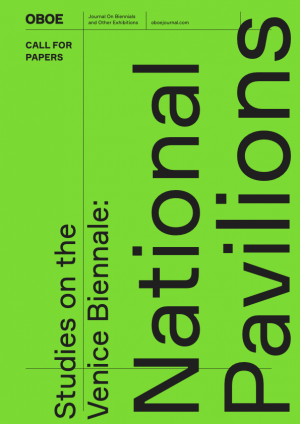Call for Papers
Studies on the Venice Biennale: National Pavilions
OBOE Journal
Many scholars have discussed the National Pavilions in the Venice Biennale, but their potential and contradictions still need to be fully addressed. A complex web of interests and administrative matters raises a whole set of questions: What advantages do National Pavilions bring to the show? How much do national political agendas matter? Can we dismiss them for simply being an obsolete formula?
National Pavilions have been criticised for their alleged traditional role, linked to a XIX century-based idea of nation, even though they have vastly contributed to the Venice Biennale as a diplomacy-oriented art space. The sheer presence of independently run international art spaces has allowed the Biennale to become a polyphonic curatorial platform, maybe with a lack of coordination, but certainly with room for multiple curatorial approaches. This point differentiated the Venice Biennale from the majority of periodic exhibitions in the contemporary art world. However, can we say that National Pavilions have been able to face or reflect on globalisation?
Often, thanks to the way artists engaged with these buildings’ spaces, in particular during the XXI century, Pavilions have proved to be critical and at times conflicting with any national celebration. These exhibition venues have frequently become spaces where the very possibility of a national identity was questioned. Many artists have also decided to escape from the pavilion’s space/time closed structure, enlarging it to include within it other venues and events happening in Venice. Along these lines, on certain occasions, National Pavilions were converted into instruments of institutional critique, heading to the crisis of a traditional idea of the show, created within a precise architectonic frame and a given calendar.
Part of the National Pavilions’ critique, that remains particularly important for surfacing margins of national reality, is the ‘rebel pavilion’. In many of these cases, exhibitions meant to culturally identify areas of a centralised state in search for political recognition and autonomy. The shows held by Scotland in a palazzo on the Grand Canal (2015), or that of Catalonia in a non-profit space at the Zattere (2009), stand as quick examples of a significant phenomenon, albeit these exhibitions would not find a place in the catalogue of the Biennale if not as collateral events. This is due to the rigid structure of the Biennale itself, which stays, after all, definitely aligned with official geopolitics. Finally, this look underlies a projection of power, with a clear, enduring emphasis on Western supremacy, which may explain why the Pavilions have been considered deplorable by many observers.
OBOE Journal invites proposals for articles that examine National Pavilions at the Venice Biennale from diverse perspectives. Possible topics might include, but are not limited to:
· Pavilions’ critique;
· The Giardini as a geopolitical space;
· Artistic discourses about the idea of nation;
· Transnational Pavilions;
· Autonomous Pavilions;
· International relations;
· Site-specific artworks;
· Histories of the Pavilions;
· Awards and International Participation;
· Comparative Art History;
· Institutional debates;
· Pavilions and Globalisation;
· Colonial and Postcolonial drives;
· Art Market.
For publication consideration, please email an abstract of 300 words together with 5 keywords and a short bio to info@oboejournal.com by March 31, 2022.
Papers selected for publication should be submitted for double-blind peer review by July 31, 2022.


